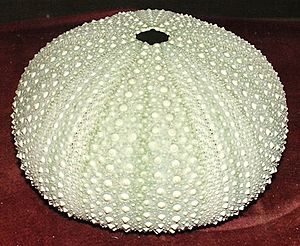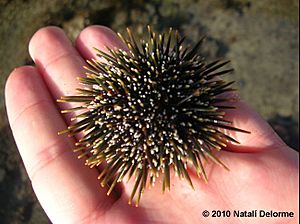Kina (animal) facts for kids
Quick facts for kids New Zealand sea urchin |
|
|---|---|
 |
|
| Scientific classification | |
| Kingdom: | |
| Phylum: | |
| Class: | |
| Order: |
Echinoida
|
| Family: |
Echinometridae
|
| Genus: |
Evechinus
|
| Species: |
E. chloroticus
|
| Binomial name | |
| Evechinus chloroticus Valenciennes, 1846
|
|
Kina (Evechinus chloroticus) is a type of sea urchin that lives only in New Zealand. It is an echinoderm, which means it's related to starfish. Kina can grow quite large, up to 16–17 centimeters across.
For a very long time, Kina has been an important food for the Māori people of New Zealand. Since 1986, people have also fished for Kina to sell. This is done in small amounts and only in certain areas. Trying to sell Kina to other countries, like those in Asia, has not worked out well. This means it's not a very profitable animal to farm.
You can find Evechinus chloroticus all around New Zealand. It also lives on some islands north and south of the main islands.
Contents
Where Kina Live
This sea urchin lives all over New Zealand in shallow waters. They usually stay about 12–14 meters deep. Some Kina also live in areas where the tide goes in and out, especially in the northern parts of both the North and South Islands.
Kina like places where the waves are not too strong. In northern New Zealand, they mostly live on rocky seafloors. But you can also find them on sandy bottoms. In the South Island, many Kina live in the deep, narrow bays called fiords.
Young Kina, smaller than 1 centimeter, hide under rocks both in tidal areas and deeper waters. Kina between 1 and 4 centimeters also hide under rocks or in small dips in the rocks. Once they grow bigger than 4 centimeters, they move out into open areas.
What Kina Eat
Kina are mostly plant-eaters. They like to eat large brown algae, red algae, and algae that grow flat on rocks. If there are too many Kina, they can eat all the kelp forests. This leaves bare rocks, which are sometimes called "Kina Barrens."
Baby Kina, called larvae, eat tiny single-celled algae. These tiny plants are between 5 and 50 micrometers in size.
Kina Predators
Some animals like to eat Kina. These include certain Molluscs, starfish, and fish that feed on the seafloor. The most important predators are the eleven-armed sea star, the seven-armed prickly starfish, and the spiny lobster.
Kina Life Cycle
Kina reproduce once a year. They become ready to have babies when they are about 3.5 to 7.5 centimeters wide. This size can change depending on where they live. Their eggs and sperm are ready from October, and they can release them from November to February.
Baby Kina larvae swim in the water for about 4 to 6 weeks. Other studies show that in a lab, they can develop in 22 to 30 days. Kina larvae like to settle on surfaces covered with certain types of red algae, like Corallina officinalis. They can also settle on artificial surfaces. A lot of dirt or mud in the water, like from building houses nearby, can harm settling Kina.
In their first year, Kina can grow about 0.8 to 1 centimeter wider. In the wild, they usually grow 1 to 2 centimeters wider each year.
Farming Kina
The inside parts of sea urchins, called gonads or roe, are very popular in some seafood markets in Asia and Europe. People want more and more of them. In New Zealand, Kina roe can sell for about NZ$70 per kilogram. However, Kina is not well known in Japan and some people think it tastes bitter. This means it doesn't sell for a high price in other countries.
Even though farming Kina is not very profitable, many studies look into how to raise them. Scientists are especially interested in making the roe better quality from Kina caught in the wild. Improving the roe could help sell them to markets like Japan.
Making the roe better for just nine weeks can give the best profit for the lowest cost. It is also more profitable to improve Kina from the North Island, as they often have less roe than those from the South Island.
Young Kina grown in a lab can grow about 1 millimeter wider each month. How fast Kina become ready to reproduce depends on the quality and amount of food they get, not just their size. They can become ready to reproduce when they are as small as 30 millimeters if they are fed a special diet.
Scientists have developed good artificial foods for sea urchins. But more research is needed for food for very young Kina. Also, better systems are needed to raise baby Kina after they settle.
Kina and Pollution
A metal called copper can be harmful to Kina at all stages of their life. Even small amounts of copper can hurt their eggs and sperm. It can also harm the swimming larvae. For adult Kina, higher levels of copper can be damaging over a couple of weeks.


